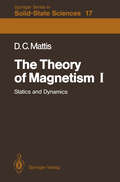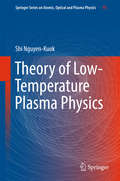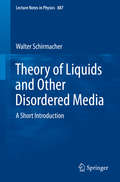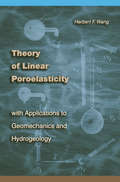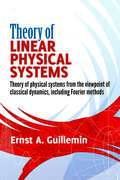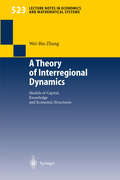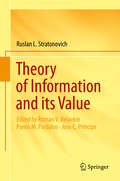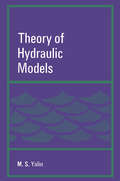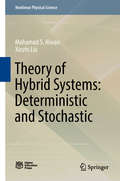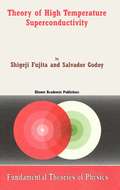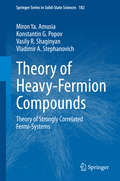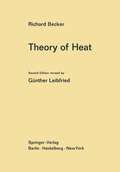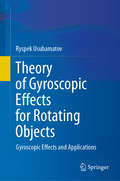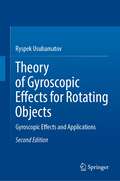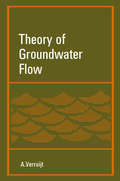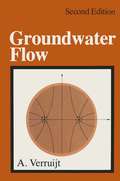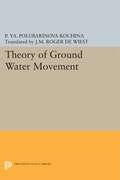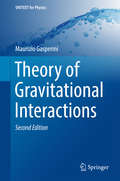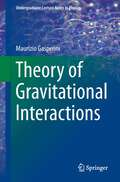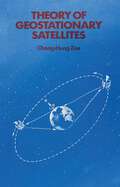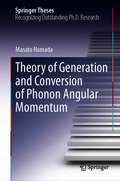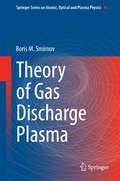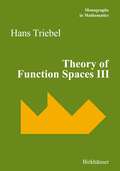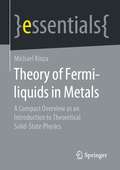- Table View
- List View
The Theory of Magnetism I: Statics and Dynamics (Springer Series in Solid-State Sciences #17)
by Daniel C. MattisStarting with a historical introduction to the study of magnetism - one of the oldest sciences known to man - before considering the most modern theories and observations (magnetic bubbles and soap films, effects of magnetic impurities in metals and spin glasses), this book develops the concepts and the mathematical expertise necessary to understand contemporary research in this field. Magnetic systems are important in technology and applied science, but they are also prototypes of more complex mathematical structures of great importance to theoretical physics. These connections are made repeatedly in this volume. After development of the necessary quantum theory of angular momentum and of interacting electron systems, a number of models which have been successful in the interpretation of experimental results are introduced: the Ising model, the Heisenberg model, the Stoner theory, the Kondo phenomenon, and so on. In the second edition the thorough approach and the main features which made the first edition a popular text have been retained. All important theories are worked out in detail using methods and notation that are uniform throughout. Footnotes and an extensive bibliography provide a guide to the original literature. A number of problems test the reader's skill.
Theory of Low-Temperature Plasma Physics (Springer Series on Atomic, Optical, and Plasma Physics #95)
by Shi Nguyen-KuokThis book offers the reader an overview of the basic approaches to the theoretical description of low-temperature plasmas, covering numerical methods, mathematical models and modeling techniques. The main methods of calculating the cross sections of plasma particle interaction and the solution of the kinetic Boltzmann equation for determining the transport coefficients of the plasma are also presented. The results of calculations of thermodynamic properties, transport coefficients, the equilibrium particle-interaction cross sections and two-temperature plasmas are also discussed. Later chapters consider applications, and the results of simulation and calculation of plasma parameters in induction and arc plasma torches are presented. The complex physical processes in high-frequency plasmas and arc plasmas, the internal and external parameters of plasma torches, near-electrode processes, heat transfer, the flow of solid particles in plasmas and other phenomena are considered. The book is intended for professionals involved in the theoretical study of low-temperature plasmas and the design of plasma torches, and will be useful for advanced students in related areas.
Theory of Liquids and Other Disordered Media: A Short Introduction (Lecture Notes in Physics #887)
by Walter SchirmacherThis set of lectures provides an introduction to the structure, thermodynamics and dynamics of liquids, binary solutions and polymers at a level that will enable graduate students and non-specialist researchers to understand more specialized literature and to possibly start their own work in this field.Part I starts with the introduction of distribution functions, which describe the statistical arrangements of atoms or molecules in a simple liquid. The main concepts involve mean field theories like the Perkus-Yevick theory and the random phase approximation, which relate the forces to the distribution functions.In order to provide a concise, self-contained text, an understanding of the general statistical mechanics of an interacting many-body system is assumed. The fact that in a classic liquid the static and dynamic aspects of such a system can be discussed separately forms the basis of the two-fold structure of this approach.In order to allow polymer melts and solutions to be discussed, a short chapter acquaints readers with scaling concepts by discussing random walks and fractals.Part II of the lecture series is essentially devoted to the presentation of the dynamics of simple and complex liquids in terms of the generalized hydrodynamics concept, such as that introduced by Mori and Zwanzig. A special topic is a comprehensive introduction of the liquid-glass transition and its discussion in terms of a mode-coupling theory.
Theory of Linear Poroelasticity with Applications to Geomechanics and Hydrogeology
by Herbert F. WangThe theory of linear poroelasticity describes the interaction between mechanical effects and adding or removing fluid from rock. It is critical to the study of such geological phenomena as earthquakes and landslides and is important for numerous engineering projects, including dams, groundwater withdrawal, and petroleum extraction. Now an advanced text synthesizes in one place, with one notation, numerous classical solutions and applications of this highly useful theory. The introductory chapter recounts parallel developments in geomechanics, hydrogeology, and reservoir engineering that are unified by the tenets of poroelasticity. Next, the theory's constitutive and governing equations and their associated material parameters are described. These equations are then specialized for different simplifying geometries: unbounded problem domains, uniaxial strain, plane strain, radial symmetry, and axisymmetry. Example problems from geomechanics, hydrogeology, and petroleum engineering are incorporated throughout to illustrate poroelastic behavior and solution methods for a wide variety of real-world scenarios. The final chapter provides outlines for finite-element and boundary-element formulations of the field's governing equations. Whether read as a course of study or consulted as a reference by researchers and professionals, this volume's user-friendly presentation makes accessible one of geophysics' most important subjects and will do much to reduce poroelasticity's reputation as difficult to master.
Theory of Linear Physical Systems: Theory of physical systems from the viewpoint of classical dynamics, including Fourier methods
by Ernst A. GuilleminAn eminent electrical engineer and authority on linear system theory takes upper-level undergraduates and graduate students beyond the average introductory circuits course, providing them with additional background for understanding advanced network synthesis. This sophisticated treatise broadens students' understanding of the topological and algebraic relations for establishing equilibrium equations and transformations between sets of variables. The text further examines energy functions in both active and passive situations as well as important properties of impedance and similar characterizing functions.The treatment also explores the evaluation and prediction of approximation and truncation errors attendant upon the use of numerical methods of direct and inverse Fourier transform evaluation; the properties of partial sums; and the interpretation of limit processes. In addition, the text stresses the relation between the Fourier and Laplace methods and the approach in classical dynamics, basing the evaluation of Fourier integrals upon meaningful physical reasoning and providing an effective tool for dealing with special problems from the viewpoint of classical dynamics.
A Theory of Interregional Dynamics: Models of Capital, Knowledge and Economic Structures (Lecture Notes in Economics and Mathematical Systems #523)
by Wei-Bin ZhangOver more than two centuries the development of economic theory has created a wide array of different theories, concepts and results. Nevertheless, there is no general theory, which mrifies these varied theories into a comprehensive one. Economics has been split between partial and conflicting representations of the functioning of market economies. We have a collection of separate theories such as the Marxian economics, the Keynesian economics, the general equilibrium theory, and the neoclassical growth theory. These diverse economic theories have co-existed but not in a structured relationship with each other. Economic students are trained to understand economic phenomena by severally incompatible theories one by one in the same course. Since the end of Second Wodd War many crises in economic theory have been announced. The economist experienced the crisis of the general equilibrium economics, the crisis of the neoclassical growth economics, the crisis of the Keynesian economics, not to mention the crises of the Marxian economics. It is quite reasonable to expect the loss of confidence in theoretical economics even among professional economists after so many crises in a very short period of time. But a crisis offers new opportmrities for change, either for better or for worse. The past crises in theoretical economics may be perceived as a historical opportmrity to construct a general economic theory by which the traditional theories are integrated into a higher whole.
Theory of Information and its Value
by Ruslan L. StratonovichThis English version of Ruslan L. Stratonovich’s Theory of Information (1975) builds on theory and provides methods, techniques, and concepts toward utilizing critical applications. Unifying theories of information, optimization, and statistical physics, the value of information theory has gained recognition in data science, machine learning, and artificial intelligence. With the emergence of a data-driven economy, progress in machine learning, artificial intelligence algorithms, and increased computational resources, the need for comprehending information is essential. This book is even more relevant today than when it was first published in 1975. It extends the classic work of R.L. Stratonovich, one of the original developers of the symmetrized version of stochastic calculus and filtering theory, to name just two topics.Each chapter begins with basic, fundamental ideas, supported by clear examples; the material then advances to great detail and depth. The reader is not required to be familiar with the more difficult and specific material. Rather, the treasure trove of examples of stochastic processes and problems makes this book accessible to a wide readership of researchers, postgraduates, and undergraduate students in mathematics, engineering, physics and computer science who are specializing in information theory, data analysis, or machine learning.
Theory of Hybrid Systems: Deterministic and Stochastic (Nonlinear Physical Science)
by Mohamad S. Alwan Xinzhi LiuThis book is the first to present the application of the hybrid system theory to systems with EPCA (equations with piecewise continuous arguments). The hybrid system paradigm is a valuable modeling tool for describing a wide range of real-world applications. Moreover, although new technology has produced, and continues to produce highly hierarchical sophisticated machinery that cannot be analyzed as a whole system, hybrid system representation can be used to reduce the structural complexity of these systems. That is to say, hybrid systems have become a modeling priority, which in turn has led to the creation of a promising research field with several application areas. As such, the book explores recent developments in the area of deterministic and stochastic hybrid systems using the Lyapunov and Razumikhin–Lyapunov methods to investigate the systems’ properties. It also describes properties such as stability, stabilization, reliable control, H-infinity optimal control, input-to-state stability (ISS)/stabilization, state estimation, and large-scale singularly perturbed systems.
Theory of High Temperature Superconductivity (Fundamental Theories of Physics #121)
by S. Fujita S. GodoyFlux quantization experiments indicate that the carriers, Cooper pairs (pairons), in the supercurrent have charge magnitude 2e, and that they move independently. Josephson interference in a Superconducting Quantum Int- ference Device (SQUID) shows that the centers of masses (CM) of pairons move as bosons with a linear dispersion relation. Based on this evidence we develop a theory of superconductivity in conventional and mate- als from a unified point of view. Following Bardeen, Cooper and Schrieffer (BCS) we regard the phonon exchange attraction as the cause of superc- ductivity. For cuprate superconductors, however, we take account of both optical- and acoustic-phonon exchange. BCS started with a Hamiltonian containing “electron” and “hole” kinetic energies and a pairing interaction with the phonon variables eliminated. These “electrons” and “holes” were introduced formally in terms of a free-electron model, which we consider unsatisfactory. We define “electrons” and “holes” in terms of the cur- tures of the Fermi surface. “Electrons” (1) and “holes” (2) are different and so they are assigned with different effective masses: Blatt, Schafroth and Butler proposed to explain superconductivity in terms of a Bose-Einstein Condensation (BEC) of electron pairs, each having mass M and a size. The system of free massive bosons, having a quadratic dispersion relation: and moving in three dimensions (3D) undergoes a BEC transition at where is the pair density.
Theory of Heavy-Fermion Compounds: Theory of Strongly Correlated Fermi-Systems (Springer Series in Solid-State Sciences #182)
by Miron Ya. Amusia Konstantin G. Popov Vasily R. Shaginyan Vladimir A. StephanovichThis book explains modern and interesting physics in heavy-fermion (HF) compounds to graduate students and researchers in condensed matter physics. It presents a theory of heavy-fermion (HF) compounds such as HF metals, quantum spin liquids, quasicrystals and two-dimensional Fermi systems. The basic low-temperature properties and the scaling behavior of the compounds are described within the framework of the theory of fermion condensation quantum phase transition (FCQPT). Upon reading the book, the reader finds that HF compounds with quite different microscopic nature exhibit the same non-Fermi liquid behavior, while the data collected on very different HF systems have a universal scaling behavior, and these compounds are unexpectedly uniform despite their diversity. For the reader's convenience, the analysis of compounds is carried out in the context of salient experimental results. The numerous calculations of the non-Fermi liquid behavior, thermodynamic, relaxation and transport properties, being in good agreement with experimental facts, offer the reader solid grounds to learn the theory's applications. Finally, the reader will learn that FCQPT develops unexpectedly simple, yet completely good description of HF compounds.
Theory of Heat
by Richard BeckerThe first objective of statistical mechanics is to explain the fundamental laws of thermodynamics from first principles based on the atomic structure of matter. This problem was attacked successfully first by MAXWELL and CLAUSIUS in studies on the kinetic theory of gases. It will be treated briefly in Sec. II-A, to gain some understanding and experience before dealing with more general problems. The second objective is then to calculate thermodynamics quantities from the microscopic laws governing the atomic motion. Whenever we try to lay the foundation of thermodynamics on an atomistic theory, we are confronted with a very strange situation. The thermodynamical state of a system is defined uniquely by only a few quantities, such as pressure, volume, energy, temperature, flow velocities, etc. In contrast, the atomistic descrip tion needs an enormous number of variables to define a state, e. g. , positions and velocities of all the atoms involved in classical mechanics or Schrodinger's wave function of the corresponding N body-problem in quantum mechanics. Classical mechanics, for instance, can predict the future development only if all the positions and velocities are known, say at time t = O. The number of values needed for this 23 purpose is of the order of 10 . Actually, only a few parameters are at our disposal from thermodynamics. Therefore, from thermodynamics we know almost nothing about the atomistic situation.
Theory of Gyroscopic Effects for Rotating Objects: Gyroscopic Effects and Applications
by Ryspek UsubamatovThis book highlights an analytical solution for the dynamics of axially symmetric rotating objects. It also presents the theory of gyroscopic effects, explaining their physics and using mathematical models of Euler’s form for the motion of movable spinning objects to demonstrate these effects. The major themes and approaches are represented by the spinning disc and the action of the system of interrelated inertial torques generated by the centrifugal, common inertial, Coriolis forces, as well as the change in their angular momentum. These torques constitute the fundamental principles of the mechanical gyroscope theory that can be used for any rotating objects, like rings, cones, spheres, paraboloids and propellers of different designs. Lastly, the mathematical models for the gyroscopic effects are validated by practical tests.
Theory of Gyroscopic Effects for Rotating Objects: Gyroscopic Effects and Applications
by Ryspek UsubamatovThis book highlights an analytical solution for the dynamics of axially rotating objects. It also presents the theory of gyroscopic effects, explaining their physics and using mathematical models of Euler’s form for the motion of movable spinning objects to demonstrate these effects. The major themes and approaches are represented by the spinning disc and the action of the system of interrelated inertial torques generated by the centrifugal and Coriolis forces, as well as the change in the angular momentum. The interrelation of inertial torques is based on the dependency of the angular velocities of the motions of the spinning objects around axes by the principle of mechanical energy conservation. These kinetically interrelated torques constitute the fundamental principles of the mechanical gyroscope theory that can be used for any rotating objects of different designs, like rings, cones, spheres, paraboloids, propellers, etc. Lastly, the mathematical models for the gyroscopic effects are validated by practical tests. The 2nd edition became necessary due to new development and corrections of mathematical expressions: It contains new chapters about the Tippe top inversion and inversion of the spinning object in an orbital flight and the boomerang aerodynamics.
Theory of Groundwater Flow (Theory And Applications Of Transport In Porous Media Ser. #2)
by A. VerruijtTheory of Ground Water Movement
by Pelageia Iakovlevna Polubarinova-Koch Roger J.M. De WiestGives valuable insight into the status of ground water hydrology in the U.S.Originally published in 1962.The Princeton Legacy Library uses the latest print-on-demand technology to again make available previously out-of-print books from the distinguished backlist of Princeton University Press. These editions preserve the original texts of these important books while presenting them in durable paperback and hardcover editions. The goal of the Princeton Legacy Library is to vastly increase access to the rich scholarly heritage found in the thousands of books published by Princeton University Press since its founding in 1905.
Theory of Ground Water Movement (Princeton Legacy Library #1968)
by Pelageia Iakovlevna Polubarinova-KochGives valuable insight into the status of ground water hydrology in the U.S.Originally published in 1962.The Princeton Legacy Library uses the latest print-on-demand technology to again make available previously out-of-print books from the distinguished backlist of Princeton University Press. These editions preserve the original texts of these important books while presenting them in durable paperback and hardcover editions. The goal of the Princeton Legacy Library is to vastly increase access to the rich scholarly heritage found in the thousands of books published by Princeton University Press since its founding in 1905.
Theory of Gravitational Interactions (UNITEXT for Physics)
by Maurizio GasperiniThis is the second edition of a well-received book that is a modern, self-contained introduction to the theory of gravitational interactions. The new edition includes more details on gravitational waves of cosmological origin, the so-called brane world scenario, and gravitational time-delay effects.The first part of the book follows the traditional presentation of general relativity as a geometric theory of the macroscopic gravitational field, while the second, more advanced part discusses the deep analogies (and differences) between a geometric theory of gravity and the gauge theories of the other fundamental interactions. This fills a gap within the traditional approach to general relativity which usually leaves students puzzled about the role of gravity. The required notions of differential geometry are reduced to the minimum, allowing room for aspects of gravitational physics of current phenomenological and theoretical interest, such as the properties of gravitational waves, the gravitational interactions of spinors, and the supersymmetric and higher-dimensional generalization of the Einstein equations. This textbook is primarily intended for students pursuing a theoretical or astroparticle curriculum but is also relevant for PhD students and young researchers.
Theory of Gravitational Interactions (Undergraduate Lecture Notes in Physics)
by Maurizio GasperiniThis reference textbook is an up-to-date and self-contained introduction to the theory of gravitational interactions. The first part of the book follows the traditional presentation of general relativity as a geometric theory of the macroscopic gravitational field. A second, advanced part then discusses the deep analogies (and differences) between a geometric theory of gravity and the gauge theories of the other fundamental interactions. This fills a gap which is present in the context of the traditional approach to general relativity, and which usually makes students puzzled about the role of gravity. The necessary notions of differential geometry are reduced to the minimum, leaving more room for those aspects of gravitational physics of current phenomenological and theoretical interest, such as the properties of gravitational waves, the gravitational interactions of spinors, and the supersymmetric generalization of the Einstein equations. Theory of Gravitational Interactions will be of particular value to undergraduate students pursuing a theoretical or astroparticle curriculum. It can also be used by those teaching related subjects, by PhD students and young researchers working in different scientific sectors but wishing to enlarge their spectrum of interests, and, in general, by all scholars interested in the modern aspects and problems of gravitational interaction.
Theory of Geostationary Satellites
by Chong-Hung ZeeGeostationary or equatorial synchronous satellites are a daily reminder of our space efforts during the past two decades. The nightly television satellite weather picture, the intercontinental telecommunications of television transmissions and telephone conversations, and the establishrnent of educational programs in remote regions on Earth are constant reminders of the presence of these satellites. As used here, the term 'geo stationary' must be taken loosely because, in the long run, the satellites will not remain 'stationary' with respect to an Earth-fixed reference frame. This results from the fact that these satellites, as is true for all satellites, are incessantly subject to perturbations other than the central-body attraction of the Earth. Among the more predominant pertur bations are: the ellipticity of the Earth's equator, the Sun and Moon, and solar radiation pressure. Higher harmonics of the Earth's potential and tidal effects also influence satellite motion, but they are of second order when compared to the predominant perturbations. This volume deals with the theory of geostationary satellites. It consists of seven chapters. Chapter 1 provides a general discussion including a brief history of geostationary satellites and their practical applications. Chapter 2 describes the Earth's gravitational potential field and the methodology of solving the geostationary satellite problem. Chapter 3 treats the effect of Earth's equatorial ellipticity (triaxiality) on a geostationary satellite. Chapter 4 deals with the effects of the Sun and Moon on the satellite's motion while Chapter 5 presents the combined influences of the Sun, Moon and solar radiation pressure. Chapter 6 describes various station-keeping techniques which may be used to make geostationary satellites practically stationary. Finally, Chapter 7 describes the verification of the theory developed in Chapters 3, 4 and 5 by utilizing the Early Bird synchronous satellite observed data as well as its numerically integrated results.
Theory of Generation and Conversion of Phonon Angular Momentum (Springer Theses)
by Masato HamadaThis book presents a theoretical study of the generation and conversion of phonon angular momentum in crystals.Recently, rotational motions of lattice vibrations, i.e., phonons, in crystals attract considerable attentions. As such, the book theoretically demonstrate generations of phonons with rotational motions, based on model calculations and first-principle calculations. In systems without inversion symmetry, the phonon angular momentum is shown to be caused by the temperature gradient, which is demonstrated in crystals such as wurtzite gallium nitride, tellurium, and selenium using the first-principle calculations. In systems with neither time-reversal nor inversion symmetries, the phonon angular momentum is shown to be generated by an electric field. Secondly, the book presents the microscopic mechanisms developed by the author and his collaborator on how these microscopic rotations of nuclei are coupled with electron spins. These predictions serve as building blocks for spintronics with phonons or mechanical motions.
Theory of Gas Discharge Plasma (Springer Series on Atomic, Optical, and Plasma Physics #84)
by Boris M. SmirnovThis book presents the theory of gas discharge plasmas in a didactical way. It explains the processes in gas discharge plasmas. A gas discharge plasma is an ionized gas which is supported by an external electric field. Therefore its parameters are determined by processes in it. The properties of a gas discharge plasma depend on its gas component, types of external fields, their geometry and regimes of gas discharge. Fundamentals of a gas discharge plasma include elementary, radiative and transport processes which are included in its kinetics influence. They are represented in this book together with the analysis of simple gas discharges. These general principles are applied to stationary gas discharge plasmas of helium and argon. The analysis of such plasmas under certain conditions is theoretically determined by numerical plasma parameters for given regimes and conditions.
Theory of Function Spaces III (Monographs in Mathematics #100)
by Hans TriebelThis volume presents the recent theory of function spaces, paying special attention to some recent developments related to neighboring areas such as numerics, signal processing, and fractal analysis. Local building blocks, in particular (non-smooth) atoms, quarks, wavelet bases and wavelet frames are considered in detail and applied to diverse problems, including a local smoothness theory, spaces on Lipschitz domains, and fractal analysis.
Theory of Fermi-liquids in Metals: A Compact Overview as an Introduction to Theoretical Solid-State Physics (essentials)
by Michael KinzaThis essential offers a compact introduction to the theory of Fermi liquid for physics students in their main studies. It forms the basis for an understanding of theoretical solid state physics and is part of every introductory lecture on this topic. After a brief overview of the Sommerfeld model of metals, the concept of the quasiparticle is introduced. Important calculations characterizing a Fermi liquid are derived in detailed calculations. The essential concludes with an overview of the microscopic theory of Fermi liquids.This Springer essential is a translation of the original German 1st edition essentials, Theorie der Fermiflüssigkeit in Metallen by Michael Kinza, published by Springer Fachmedien Wiesbaden GmbH, part of Springer Nature in 2018. The translation was done with the help of artificial intelligence (machine translation by the service DeepL.com). A subsequent human revision was done primarily in terms of content, so that the book will read stylistically differently from a conventional translation. Springer Nature works continuously to further the development of tools for the production of books and on the related technologies to support the authors.
